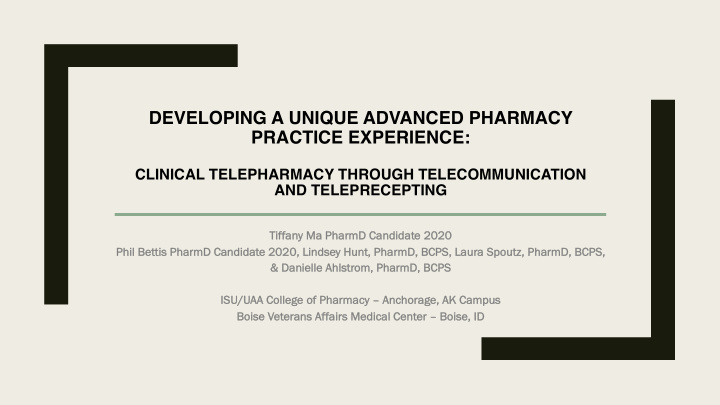



DEVELOPING A UNIQUE ADVANCED PHARMACY PRACTICE EXPERIENCE: CLINICAL TELEPHARMACY THROUGH TELECOMMUNICATION AND TELEPRECEPTING Ti Tiffany y Ma Ma Ph PharmD Candidate 2 2020 Ph Phil Be Bettis is Ph PharmD Ca Candidate 2020, , Lindsey H Hunt, , Ph PharmD, , BCPS, L , Laura Sp Spoutz, , Ph PharmD, , BCPS, , & & Danielle A Ahlstrom, , Ph PharmD, , BC BCPS IS ISU/UAA C College of P Pharmacy – Anchorage, , AK C Campus Bo Bois ise Veterans A Affairs M Medical C Center – Boise, , ID ID
DISCLOSURE I am the remote student in this presentation and completing this rotation was a requirement for both my college of pharmacy and for licensure with the state of Alaska. However, I have no relevant financial relationships to disclose.
Pretest ■ Can an APPE rotation successfully be completed in its entirety remotely via telecommunication and teleprecepting? True or False? ■ Which is NOT a barrier to successfully completing an APPE via telecommunication? – A. Time zone differences – B. Technical and/or connectivity issues – C. Political differences ■ What would you consider to be an absolute requirement for an APPE to be considered successful?
OBJECTIVE Upon c conclusion o of t the p program, t , the p participant s should b be a able t to describe h how a an A APPE r rotation c can b be c completed b by a a r remote s student entirely t through te teleprecepting and t telecommunication.
Background The Veterans Integrated Service Network 20 (VISN 20) telehealth APPE • • Well-practiced model of clinical pharmacy care to remote locations • Onsite students experience telehealth as practicing clinical telehealth pharmacist The novel idea to offer this experience entirely via telecommunication to a • remote student was unprecedented. The remote student is part of an inaugural PharmD program in Alaska • A unique APPE to learn about telehealth pharmacy practice •
PURPOSE This r rotation w was d designed t to o offer t the c complete a advanced p pharmacy practice e experience ( (APPE) t to a an i inaugural p pharmacy s student l located i in Anchorage, A , Alaska, i , in i its e entirety t through t the i innovative r route o of te telecommunication an and te teleprecepting.
Methods Every day the remote student met via telecommunication with a preceptor located in Boise • The student attended meetings, topic discussions, and student presentations; presented • topic discussions, a journal club, and a clinical case; shadowed providers, answered drug information questions, conducted patient appointments, and wrote progress notes, all through telecommunication. The student completed various projects across the continuum, such as a student-derived • poster and a student-specific telehealth APPE guidebook. As a measure to establish parity between the student experiences, a detailed comparison • of each students’ schedule was examined at the end of the rotation. Due to the unique circumstances of the remote student’s onboarding schedule, access to • patient information was not granted until the end of week two and the comparison between student schedules began then.
Results Onsite S Student Re Remote St Student 4 presentations 5 presentations 4 topic discussions 9 topic discussions 1 drug information q’s 3 drug information q’s 4 electronic consult q’s 5 electronic consult q’s 5 clinical pharm meetings 9 clinical pharm meetings 10 provider shadows 8 provider shadows 27 appts conducted 16 appts conducted 35 no show appts 9 no show appts 2 lost appts to technical issues 3 lost appts to technical issues
Results
For both students, the types of patient appointments weighed heavily in diabetes, then tobacco cessation, and least in other chronic conditions. Appointment types were recorded according to initial chief complaints and did not always accurately reflect all the disease states actually addressed in each visit.
Discussion • Where the results show more exposure to direct patient contact and no show appointments for the onsite student, the remote student had more exposure to drug information/electronic consults questions, topic discussions, presentations, projects, and pharmacy/clinical pharmacy meetings. Con Concl clusion on • Teleprece cepting a r remote s student v via t teleco communica cation p proved t to b be succe ccessful i in d delivering a an A APPE e experience ce co comparable t to a an o onsite student i in e exposure t to t types o of d disease s states a and o overall cl clinica cal telepharmacy cy pract ctice ce. .
FUTURE CONSIDERATIONS Im Improvements t to t technological b barriers a and i increased e exposure t to d direct p patient ca care re appointments c could ma make th the remote a and o onsite s student e experiences in indis istin inguis ishable in in the f future. .
Post Test ■ Can an APPE rotation successfully be completed in its entirety remotely via telecommunication and teleprecepting? Tr True or False? ■ Which is NOT a barrier to successfully completing an APPE via telecommunication? – A. Time zone differences – B. Technical and/or connectivity issues – C. P . Political d differences ■ What would you consider to be an absolute requirement for an APPE to be considered successful? Se Self re relfection
SPECIAL THANKS • VIS ISN 2 20 t telehealth p pharmacist p preceptors f for a accommodating a and provi viding a a u unique A APPE r rotation t to t the r remote s student und under pa particularly y special c circumstances. • IS ISU, e , especially D Dr. T . Tom W Wadsworth & & D Dr. P . Paul B Black, f , for y your t tireless efforts t to d deliver e excellent s student o opportunities!
Recommend
More recommend